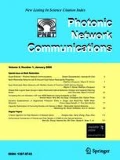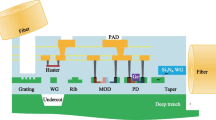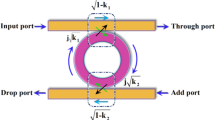Abstract
In recent years, p-cycles have been widely investigated for survivability of WDM networks. They provide fast recovery speed such as ring and capacity efficiency as mesh survivability schemes. However, restoration paths are very long, which causes excessive latency and intolerable physical impairments. On the other hand, nowadays, a wide set of applications require an optical path with almost no delay. The existing approaches, namely loopbacks removal and inter-cycle switching, provide a significant reduction in the restored path, but even then a number of restored paths remain many times longer than the working path lengths. In this paper, we propose a network partitioning-based approach to control the length of each restored path as per delay sustainability of time critical applications. The basic idea of the work is to partition the network into domains and construct the p-cycles for each domain independently. The domain wise construction of p-cycles restricts their length, which consequently reduces the length of restored paths. Here, we introduce a new concept where the selected border nodes are overlapped among adjacent domains to cover inter-domain spans of the network as a domain span in order to ensure their survivability through domain p-cycles. Simulation results show that the proposed solution is good enough to control the restored path length with small augmentation in redundancy of spare capacity as compared to optimal design of p-cycles. More importantly, it enhances the dual failure restorability significantly.





Similar content being viewed by others
References
Cisco Inc.: Cisco visual networking index -forecast and methodology, 2012–2017, White paper. In: SPIC Proceeding, vol. 900 (2013)
Gerstel, O., et al.: Elastic optical networking: a new dawn for the optical layer. IEEE Commun. Mag. 50, 512–520 (2012)
Ramamurthy, S., Sahasrabuddhe, L., Mukherjee, B.: Survivable WDM mesh network. J. Lightwave Technol. 21(4), 870–883 (2003)
Grover, W.D.: Mesh-Based Survivable Networks: Options and Strategies for Optical, MPLS, SONET, and ATM Networking. Prentice Hall, Upper Saddle River (2004)
Grover, W. D., Stamatelakis, D.: Cycle-oriented distributed pre-configuration: ring-like speed with mesh-like capacity for self-planning network restoration, Proc. IEEE International Conference on Communications (ICC). Atlanta, Georgia, USA, (1998), pp. 537–543
Kiaei, M.S., Assi, C., Jaumard, B.: A survey on the \(p\)-cycle protection method. IEEE Commun. Surv. Tutor. 11(3), 53–70 (2009)
Asthana, R., Singh, Y. N., Grover, W.D.: \(p\)-Cycles - An overview, Communications Surveys & Tutorials, IEEE, 12(1):97-111, First Quarter (2010)
Wensheng, H.,Somani. A. K.: Comparison of Protection Mechanisms - Capacity Efficiency and Recovery Time, In: IEEE International Conference on Communications—ICC, 2218–2223, (2007)
Wei,Y., Xu, K., Zhao, H.: Applying p-cycle Technique to Elastic Optical Networks, ONDM 2014, 19–22, Stockholm, Sweden, (2014)
Wei, Y., et al.: Optimal design for \(p\)-cycle protected elastic optical networks. Photonic Netw. Commun. 29, 257 (2015). doi:10.1007/s11107-015-0490-6
Li, B., et al.: Application of forecasting based dynamic \(p\)-cycle reconfiguration under reliable optical networks in smart grid. Comput. Commun. 49, 48–59 (2014)
Bobrovs, V., Spolitis, S., Ivanovs, G.: Latency cause and reduction in optical metro networks, Proceding of SPIE, vol. 9008, p. 1, (2004) (Invited paper)
O3b Networks Ltd.: What is network latency and why it matters? White paper (2011)
Asthana, R., Singh, Y. N.: Removal of Loop Back in p-cycle Protection-Second Phase Reconfiguration, In: Proceedings of IEEE International Conference on Communication Systems, Singapore, Oct. 30–Nov. 1, (2006)
Asthana, R., Singh, Y.N.: Distributed protocol for removal loop backs and optimum allocation of \(p\)-cycles to minimize the restored path lengths. J. Lightwave Technol. 26(5), 616–627 (2008)
Huang, S., et al.: Distributed protocol for removal of loop backs with asymmetric digraph using GMPLS in \(p\)-cycle based optical networks. IEEE Trans. Commun. 59(2), 541 (2011)
Yadav, R., Yadav, R.S.: Two dynamic reconfiguration approaches for optimizing the restoration path length in \(p\)-cycle protection network. Optoelectron. Lett. 6(4), 291–294 (2010)
Stamatelakis, D., Grover, W. D.: Distributed Reconfiguration of Spare Capacity in Closed Paths for Network Restoration,” U.S. Patent Pending, July 11, (1997)
Kernighan, B.W., Lin, S.: An efficient heuristic procedure for partitioning graphs. Bell Syst. Tech. J. 49, 291–307 (1970)
Drid, H.: Survivability in multi-domain optical networks using p-cycles. Photonic Netw. Commun. 19(1), 81 (2009). doi:10.1007/s11107-009-0213-y
Author information
Authors and Affiliations
Corresponding author
Rights and permissions
About this article
Cite this article
Singh, H.M., Yadav, R.S. Partitioning-based approach to control the restored path length in p-cycle-based survivable optical networks. Photon Netw Commun 33, 1–10 (2017). https://doi.org/10.1007/s11107-016-0659-7
Received:
Accepted:
Published:
Issue Date:
DOI: https://doi.org/10.1007/s11107-016-0659-7




